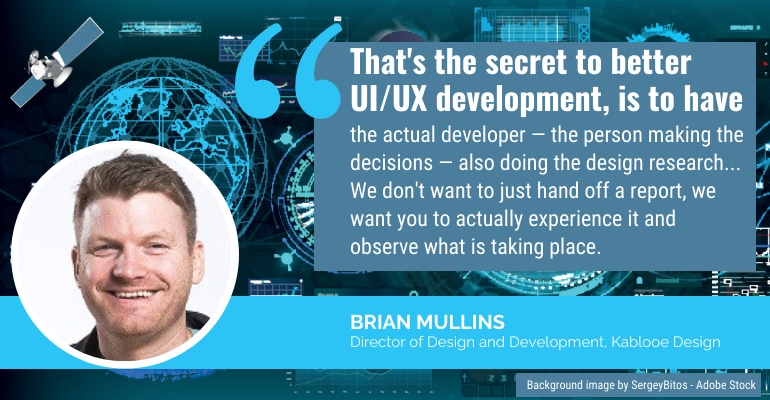Virtual Engineering Week speakers from Kablooe Design share practical tips for doing great user interface and user experience (UX/UI) in medical device design.
December 2, 2020

If user interfaces on a consumer electronic are unclear, it results in frustration and wasted time. In medical device design, if user interfaces are unclear, results could be far more serious. During Virtual Engineering Week, experts from Kablooe Design, a Coon Rapids, MN-based firm, shared key considerations for designing a medical device user interface (UI) and user experience (UX).
Understand what your users need to be successful with the interfaces
"Think about the big picture — what is the team of individuals trying to do? What is the overall process that they're going through? — And then those little needs within the larger needs come into play," said Brian Mullins, director of design and development at Kablooe Design. "That's really where those kernels of discovery can become so important."
Mullins defined design research as all activities involved in gathering sufficient data to enable the development staff to make informed decisions about the potential design of the object in question.
"Sometimes we're watching videos on YouTube, other times we're testing and evaluating physical competitor products, the best way though is in field research ethnographic study," Mullins said.
That type of research is very rich, he said, and allows the product designer to act as a fly on the wall gathering observational data.
Tom KraMer, president and CEO at Kablooe Design, further explained big need vs. little need using a transcatheter valve as an example.
"You're doing a transcatheter valve and you need to replace this valve better and faster, that's a big need," KraMer said. "The little need is all the little things that everybody does around that. The same thing applies just in the user interface alone, there's a big need in the user interface. You need to achieve a task in this user interface, in this user experience, and then there's little needs around what the person is going through when they're trying to achieve that task. And doing this kind of research that Brian is talking about leads to innovative solutions in that area."
Mullins added that when you discover those little needs within the larger need, it does allow you to understand the tasks necessary to do the job.
"Then you can decide which needs to focus on, and that's where a lot of that value comes from," he said.
It's also important to share your findings with your team. Or better yet, involve them in the research.
"What we like to do is have a multidisciplinary team also doing the research. So sometimes it's an engineer going into the field gathering those little needs or larger needs, or a designer," Mullins said. "Really, it doesn't matter what your background is, what we want is if you're going to be a developer, that's the secret to better UI/UX development is to have the actual developer — the person making the decisions — also doing the design research, it's very important. We don't want to just hand off a report, we want you to actually experience it and observe what is taking place."

Apply creative and technical principles in your medical device design
Mullins presented several creative and technical principles that can be applied in medical device design — both for digital as well as physical devices. The first such principle is a quick understanding of operational status. In other words, the user should be able to quickly understand the status of the device, such as if it is powered on, needs priming, etc.
The second medical device design principle he talked about is affordances, properties of the device that show users what actions they can take. For example, the design should help to inform the user what they need to do with the device in order to be successful. Affordance comes into play in the status of a button, in the way an object should be held, and how/where to connect something.
The next principle Mullins talked about is bail out ability, which is very common in a digital interface. For example, having a home button the user can push or touch to take them back to the home screen.
Consistency is also important, he said, noting that devices should have a consistent look and feel across the whole platform so that everyone understands what the brand is, and with that brand recognition comes certain user expectations.
"We don't want a user to think, 'oh, this could be from another brand, or to have any kind of mismatching things going on with respect to a graphical user interface or a piece of hardware," Mullins said.
The next medical device design principle he talked about has to do with recognizing that nobody has a perfect memory, so he encouraged attendees to show users their options, and to keep instructions handy and visible for the task.
Another principle to keep in mind is that less is more, he said, pointing out that users need to understand situations and make decisions quickly.
"Once you simplify the user interface, the user should be able to be more successful with the job that they're working on," Mullins said.
On the other hand, you don't want to get too simple with the design either.
"Sometimes we have clients come to us and they say, 'We only want to do this one thing, and this other piece of hardware we want to do this thing as well.' Very often it just makes a lot of sense from a cost standpoint to maybe combine one or two functionalities," he said. "But if you keep combining these functionalities then it gets way too complex and then it can be really difficult to use, and then use errors come into play ... So, we love simplicity but not for the sake of simplicity."
The final medical device design principle Mullins talked about has to do with the use of icons and labels.
"Language comes into play with this one, but what we're really talking about is, how do we communicate functionality of a physical or digital interface? Icons are great, but there's a lot of subjectivity with respect to icons, so you have to be really careful with what you're showing," he said, adding that it can help to pair icons with labels when it makes sense to do so.
Give the user 'something else' (a.k.a. the wow factor)
"What we're saying here is interfacing with your KOLs in the medical space is hugely valuable ... that wow factor is getting their feedback before you get too far," Mullins said. "I would say that is the third key to doing great UX/UI design is completing that usability test."
Usability studies are a bit more challenging during a pandemic, but Mullins said even showing a potential user a prototype over a Zoom call can be important. KraMer added that the wow factor goes back to discovering the little needs within the larger need.
"That's where the wow factor comes in and you get that extra 'something else' is when you've dug into all those little needs that surround the big need that you're trying to solve," KraMer said. "Hitting those little needs, suddenly you're going to have a wow factor that users are just going to warm up to, and it's going to be something that the competition doesn't have, it's going to be something that gives you marketplace advantage because users are going to gravitate towards this solution that provides something else."
About the Author(s)
You May Also Like





